 Image search results - "lantern" Image search results - "lantern" |

One of the Big Three Festivals in Tohoku, the Kanto Matsuri has men in happi coats balancing tall paper lantern-bedecked bamboo poles, called kanto, on their foreheads, shoulders, hand palms, or hips. Held on Aug. 3 to 6 near JR Akita Station.A kanto is carried to the festival site before nightfall.
|
|

Yasukuni Shrine during the Mitama Matsuri before dark.
|
|
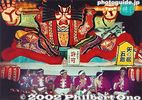
Nebuta are giant, wire-frame, paper lanterns shaped in various legendary and macho characters.The Aomori Nebuta Matsuri is held in Aomori City in Aomori Prefecture during Aug. 2-7. Nebuta are giant, wire-frame, paper lanterns shaped in various legendary and macho characters such as samurai warriors, demons, and gods. They are fantastic works of art dramatically illuminated from the inside. The floats are paraded along the main streets of the city near Aomori Station every night of the festival.
From August 2 to 6, the Nebuta parade is held from 7 p.m. to 9 p.m. On the 2nd and 3rd, the parade is geared for the many children who participate by pulling the floats. About 15 large Nebuta floats and some small Nebuta floats for the children are paraded.
The festival's peak period is from the 4th to the 6th when over 20 large Nebuta floats make their rounds. Be sure to see the festival on one of these three nights.
On the 7th, the last day, the parade is in the afternoon from 1 p.m. to 2:30 p.m. Later in the evening, the Nebuta floats are put on boats to be highlighted by a fireworks display.
The festival is designated by the government as an Important Intangible Folk Culture Asset and not to be missed if you have the chance. It's well worth the trip up north.
|
|

Moving the Neputa floats into position.Held during Aug. 1-7, the Hirosaki Neputa Matsuri is without the rowdiness of the Aomori Nebuta Matsuri. Instead of the haneto, there are many children pulling the floats with ropes. The main floats are fan-shaped and more two-dimensional and lantern-like. As with the Nebuta floats, the Neputa floats are handpainted and illuminated from the inside. There are two parade routes which are followed alternately on different nights. On the 7th, there is only a daytime parade from 10:00 a.m. If it rains on any day, the parade may be canceled.
|
|

The festival is held along a straight, 800-meter section of San'o Odori Road, a 20-min. walk from Akita Station.In the evening, the main event starts at 6:38 p.m. with a taiko drum-beating performance or minyo dancers on San'o Odori Road. At 7:17 p.m., some 200 kanto are carried into the street to the sound of flutes and taiko drums. At 7:40 p.m. following a brief address by the city's mayor, the performance begins as the kanto are raised all at once.
|
|
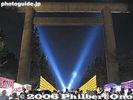
Yasukuni Shrine's main torii during Mitama Matsuri
|
|
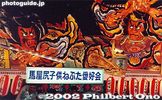
The Nebuta floats are judged in a contest and various awards are given.The Nebuta floats are beautiful objects of light. They are swung left and right and all around. The crowd applaud whenever the Nebuta faces them directly. The sculpture's lights inside are powered by a noisy generator on wheels under the float. The parade progresses quickly and the splendid Nebuta figures pass by one after another. You have to be there in person to feel the power and presence of the giant Nebuta. They represent the very soul and spirit of men. It's enough to give you goose bumps.
The Nebuta floats are judged in a contest and various awards are given. The best ones are preserved at the Nebuta-no-Sato (Nebuta Village) after the festival.
|
|
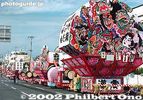
There are three types of floats: the large fan-shaped Neputa, Nebuta-type figures, and the children's small Neputa.I got to Hirosaki early enough before the parade to see the floats lined up at the starting point. Hirosaki is a 30-min. train ride from Aomori, and best known for Hirosaki Castle during cherry blossom season.
|
|
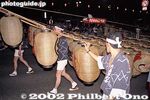
A kanto is carried into the street to the sound of flutes and taiko drums.
|
|

Promenade to the shrine
|
|
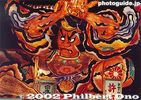
According to one story, the Nebuta has its roots in the 8th century.According to one story, the Nebuta has its roots in the 8th century when there was a rebellion in Ezo (Hokkaido). Ordered by Emperor Kanmu to quell the rebellion, generalissmo Sakanoue no Tamuramaro went to Ezo. However, he failed to capture the elusive chief of Ezo who went into hiding in the mountains.
Sakanoue then set up a trap with large votive lanterns which were lit and accompanied by taiko drums and flutes. This lured the curious Ezo chief out of hiding and led to his capture. The large lanterns were the forerunner of the Nebuta.
|
|

Lunch break
|
|
|
|

Spotlights create a silhouette of the statue of Omura Masujiro (1824-1869) 大村益次郎, founder of Japan's modern army.
|
|
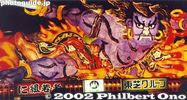
The first Nebuta was a large paper lantern made in 1593.According to historical records, the first Nebuta was a large paper lantern made in 1593 by Lord Tamenobu of Tsugaru (now part of Aomori) for the Bon festival in Kyoto. The Nebuta Festival itself started in the late 17th century.
|
|
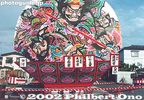
Fan-shaped Neputa float.The painted picture on the front of the Neputa depicts mostly warriors and on the back are beautiful courtesans.
|
|

The largest kanto is 12 meters high, weighs 50 kilograms, and has 46 paper lanterns. The smaller kanto are 5 and 7 meters high. The kanto symbolizes a ripe rice plant with unhusked golden grains (the paper lanterns). The festival is therefore a prayer for a good harvest.
|
|

A bon dance around the base of the statue.
|
|
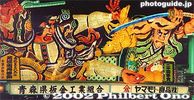
Preparation for building a Nebuta sculpture starts right after the preceding Nebuta Festival.Preparation for building a Nebuta sculpture starts right after the preceding Nebuta Festival. During fall and winter, Nebuta artists conceive the ideas for the next year's Nebuta floats. The Nebuta figures depict some scene from kabuki or Japanese/Chinese history or legend. Once a theme is chosen, a sketch or design is made and presented to the sponsor (usually a company). Upon approval, actual construction begins.
During February and March, the smaller parts of the Nebuta figure, such as the hands and fingers, are constructed at home with steel wiring.
In May, a tent village is put up. In each tent, full-scale construction of the Nebuta is executed until the end of June. Steel wiring and slender pieces of wood are used to build the frame and props.
After the skeleton of lumber and wire is completed, about 400 light bulbs and fluorescent lights are installed inside. The lights are strategically placed so that the shadow of the lumber pieces is not cast outward.
Then comes the tedious task of pasting washi paper on the wire frame. This is done by highly-skilled housewives who have been doing it for 10 to 20 years. About ten of them work on one Nebuta, taking about 10 days. Since they have to work dextrously in all sorts of contorted positions, it is not a popular job and fewer women are willing to do it.
The paper is cut to fit the exact segment (usually rectangular) on the wire frame. A toothbrush is used to apply glue on the wiring and the paper is pasted and cut. Extra care is taken when the figure's face is papered. About 2,500 sheets of 531 x 393 mm paper are consumed in the process.
|
|

The floats were jerked left and right and spun around.At 7:00 p.m., the taiko drum-beating started and the floats left the starting point one by one. The beat of the taiko drums was the same as that in the Nebuta Matsuri. A few men stood on the top of the large Neputa and collapsed the hinged, top portion to clear overhead power lines. The floats were jerked left and right and spun around.
|
|
|
|
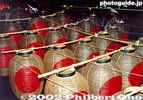
During the festival period, several events are held in the daytime. One is the "Kanto Challenge Corner" where the first 100 applicants on each day can try balancing the smaller kanto. Each participant receives a "Kanto Master" certificate. There is also the Kanto Myogi (Stunt) Contest where group and individual participants compete to be the year's best kanto technician.
|
|
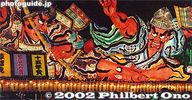
There are fewer than 30 Nebuta artists in the world.The giant white figure is brought to life by a Nebuta artist who paints it all by himself. First, the figure's basic outlines are painted with black sumi ink. Liquid paraffin is then applied to prevent the ink from running. Then colored dyes are painted or sprayed. When it comes to the face, very special care is taken. If he makes a mistake on the face, the paper is torn away and new sheets are pasted on. The very last thing painted on the Nebuta are the eyeballs. They give the sculpture its soul.
The completed Nebuta is lifted from the ground by 50 people onto a 1.5-meter-high wheeled platform. An illumination test symbolizes the Nebuta's completion. To ensure easy movement on the street, the Nebuta float is restricted to a width of 9 meters and a height of 5 meters. The float also bears the name of the sponsoring company or organization. It costs 10 to 20 million yen to build and operate a large Nebuta float. Corporate sponsors think it's money well spent since the Nebuta makes a great advertising vehicle and enhances the corporate image.
Top Nebuta artists are given over 3 million yen to cover labor and materials costs. By the time all the bills are paid, the artist has less than one-third the amount as compensation. Obviously, Nebuta artists are grossly underpaid for their highly-appreciated work. It really is a labor of love, and not for the money.
There are fewer than 30 Nebuta artists in the world, and only three of them work as full-time Nebuta artists. Since there is no money in it, would-be Nebuta artists and apprentices are few. To make it worse, there are no governmental measures to help resolve the problem.
|
|

Nebuta-type float with a paper sculpture of a figure.
|
|
|
|

Balancing act. The kanto symbolize rice plants ready to be harvested.This is perhaps the most anxiety-provoking festival. Men in happi coats balance these tall paper lantern-bedecked bamboo poles, called kanto, on their foreheads, shoulders, hand palms, or hips. While watching, you can't help thinking, "Will it fall?" or worse, "Will it fall on me?" The candle-lit paper lanterns contrasted nicely against the dark sky.
|
|

The Nebuta festival is a great visual spectacle as well as a sound delight.The Nebuta festival is a great visual spectacle as well as a sound delight. The resounding beat of the taiko drums and the shrill of the flutes give the festival its soul. These are placed at regular intervals throughout the parade. The taiko beat is simple and repetitive, yet powerful and infectious.
|
|
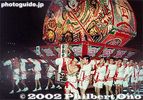
Neputa float. All the floats are on wheels so these people are not actually carrying the floats.
|
|

Spotlights hit the torii.
|
|

The objective is to balance the kanto steady enough so that the candles in the paper lanterns don't go out. The performer has to move about deftly whenever there is a gust of wind or when the pole starts to bend over. After attaining a steady balance, the skillful technician shifts the pole to other parts of his body while his surrounding colleagues clap and shout "Dokkoisho! Dokkoisho!"
Occasionally, someone loses his balance and the pole and lanterns come crashing down on the power lines, safety ropes, or right on the crowd. When I was there, one came crashing down on the crowd I was in. We all screamed. But it was surprisingly harmless. All the lanterns flamed out and some lanterns had holes. The lanterns were just relit and raised again. Falling kanto added real drama.
|
|

Distinctly-costumed dancers called haneto.Each Nebuta float is accompanied by thousands of distinctly-costumed dancers called haneto. The huge Nebuta overlook a sea of haneto out in front with their colorful flowered straw hats bobbing up and down. They jerk and jingle and hop all over the road while shouting "Rasse, Rasse, Rassera!" They twist and shout amid reverberating taiko drums and flutes.
Sometimes they form a small circle and dance in unison. Their costumes have little bells which often fall off. Little kids run and pick up the fallen bells on the road. It is a frenzied celebration. If you want to join in the fun, you have to rent or buy a haneto costume (for around ¥10,000).
|
|
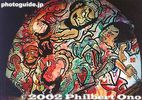
Closeup of a Neputa float.Theories concerning the origin of the Neputa are identical to those of the Nebuta. However, in the 1880's, the Neputa gradually changed from human figures into a fan shape. The floats have come a long way since then. Candles have been replaced by generator-powered lights and the washi paper has been replaced by washi paper blended with nylon. The festival is designated as an Important Intangible Folk Culture Asset.
|
|

The tallest kanto is 8 meters high. It is made higher by connecting bamboo pole extensions at the bottom. The more skillful men added more pole extensions than usual or fanned themselves with a fan while balancing the kanto. At halftime, everyone took down the kanto and they moved out. Another group of kanto masters came in and the spectacle restarted.
|
|
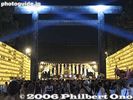
At night, 30,000 lanterns light up. A real summer spectacle.
|
|

The parade route is quite long, and it's crowded along the parade route near Aomori Station.The parade route is quite long, and it's crowded along the parade route near Aomori Station. If you want plenty of elbow room while viewing, go toward the end of the parade route where the crowd is sparse.
In recent years, the Nebuta Festival has seen disturbances caused by gate-crashing, young hoodlums. A large police force is put in place to prevent trouble.
|
|

People pull the float along.
|
|
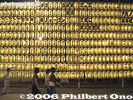
The lanterns are lit by lightbulbs, not candles.
|
|

Held during Aug. 3-5 at Taga Taisha Shrine, the Mantosai or 10,000-Lantern Festival is a night festival when numerous lanterns are lit within the shrine grounds. The lanterns are for the repose of ancestral spirits.
|
|

Notice the little pad on his forehead where he will balance the pole next.It takes years to master kanto stunts. The best performers started training during childhood. From the beginning of July, you can see people practicing on Akita's uncrowded streets. Fathers teach their children as the rest of the family watch. Although today's kanto masters hail from various occupations, in the past, the kanto performers were mostly perfectionist artisans. The kanto is based on this artisan spirit. A kanto has to be constructed perfectly. Otherwise, it is remade all over again.
|
|
|

And sometimes they have to stop it.
|
|

The kanto's paper lanterns and the performers' happi coats are emblazoned with the crest of the respective city block.Thirty-seven city blocks were represented. There were also corporate logos on some lanterns.
|
|
|

Taga Taisha Shrine torii near Taga Taisha-mae Station. MAP
|
|
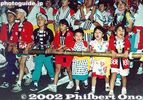
Children's night at Aomori Nebuta MatsuriOn the 2nd and 3rd, the parade is mainly for children who participate by pulling the floats. About 15 large Nebuta floats and some small Nebuta floats for the children are paraded.
|
|

Float pullers at Hirosaki Neputa Matsuri
|
|

Tanabata streamers festoon the gate.
|
|

Road to Taga Taisha Shrine
|
|
|
|

Some female haneto taking a break after the festival.
|
|
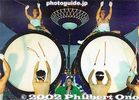
The beat was the same as at the Nebuta Festival.There were also many giant taiko drums with female taiko drummers.
|
|
|

Homes along the way are decorated.
|
|

Taking it to the limits.This guy is balancing a super-high kanto while the pole arches to an extreme degree. During the final moments, he ran across the road to maintain the balance long enough for the pole to snap under the weight of the lanterns. That was really neat. In the right photo, a crashed kanto is readied for another balancing attempt.
|
|
|

The long, slender drum sticks make a very penetrating, slapping sound.The drum sticks are long, slender, and slightly elastic. They make a very penetrating, slapping sound. It's a real treat to watch these vivacious women beating these huge drums in unison.
|
|

At 6:30 pm, a mikoshi portable shrine was paraded along the promenade.
|
|

Near the shrine entrance are the usual food stalls.
|
|

Notice the kanto in the background caught in the power lines.The kanto performance has also been introduced overseas. The first overseas performance was held in San Diego, California in 1976 as part of America's bicentennial celebration. Since then, kanto performances have been well-received in Australia, Hawaii, China, Italy, Germany, France, Brazil, and England.
|
|

Nebuta Danchi village where the floats are stored during the day.During the day, the Nebuta floats are housed in a tent village (Nebuta Danchi) open to the public. Each Nebuta has its own giant, green tent. These are the same tents used when the Nebuta were constructed.
|
|

Drumming at sunset.The Neputa Festival is not as big as the Nebuta Festival and has smaller floats, but it has its own, unique attractions. Hirosaki is a highly recommended side trip from Aomori.
|
|

Festival during the day.
|
|
|
|

Crash
|
|

Many children come and sit in front of the Nebuta to sketch it.
|
|
|
|

Welcome to Taga
|
|

A broken paper lantern is disposed of.At 8:40 p.m., the main performance stopped and the spectators were invited to try their hand at the kanto for 10 minutes. At 8:50 p.m., all the kanto were withdrawn from the site.
|
|
|

Nice during the day, but more dramatic at night.
|
|
|
|

Taga Taisha Shrine torii
|
|

This young girl was quite a talented artist who drew the attention of the other kids.
|
|
|
|
|
|

Mantosai sign under the torii
|
|

Perhaps she might be able to help paint (or build) the real thing someday.
|
|
|
|
|
|

Arched bridge leading to shrine gate.
|
|

Taiko drummer
|
|

One of the giant spotlights used to accent the mikoshi, torii, and night sky.
|
|
|
|
|
|
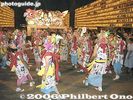
After the mikoshi, the Nebuta float and haneto dancers make an appearance.
|
|
|
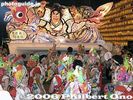
Rassera-rassera!
|
|

Kids carrying mikoshi portable shrine. They went to the train station.
|
|

Nebuta float and haneto dancers. Also see the video at YouTube.Mitama Mtasuri at Yasukuni Shrine.
|
|

Taga Taisha's lanterns come in five sizes. Each one represents a donation. The donar's name is on the lantern. The biggest lantern requires a donation of 20,000 yen.
|
|

Yukimi Stone Lantern
|
|

Awa Odori dancers also performed.
|
|

Each lantern is lit with a small lightbulb. (No candles)
|
|
|
|

Festival schedule, starting at 5:30 pm and ending after 9 pm.
|
|
|
|

Nebuta close-up
|
|

Approaching the main shrine hall.
|
|

Nice to see a bit of Aomori in Tokyo.
|
|

These lanterns above are the smallest ones, requiring a donation of only 1,500 yen. They are the most numerous.
|
|
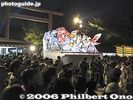
After the Nebuta made its way in front of the shrine, a short prayer was held.
|
|

Main shrine hall
|
|
|

These lanterns hanging in the main shrine hall must be the most expensive ones.
|
|
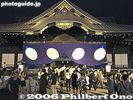
The shrine
|
|

The shrine also recently got its roof rethatched. The roof looked spanking new.
|
|

The Nebuta then went back to the promenade.
|
|

As evening approaches, the crowd increases.
|
|
|

Torii with lanterns lit
|
|
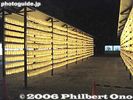
Lanterns
|
|

Minami Kannon-yama float
|
|

Gate to shrine
|
|
|
|
|

Minami Kannon-yama float
|
|
|

The lanterns are written with the names of the donors.
|
|

Minami Kannon-yama float and flute players
|
|

Direct path to Taga Taisha Shrine hall
|
|
|

Lanterns at night
|
|

Stage entertainment is also provided during the festival.
|
|
|
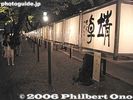
The bigger lanterns have artwork. Some of them were done by celebrities.
|
|
|
|
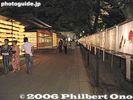
Path to the Yushukan war museum.
|
|
|
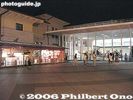
Yushukan war museum
|
|

Entertainment on stage
|
|

Next to the museum was a display of different lanterns, including a Neputa (left) and Nebuta (right).
|
|
|
|

Entertainment with a dragon dance
|
|
|
|

Neputa is from Hirosaki, Aomori Pref.
|
|
|
|

Neputa closeup
|
|
|
|
|
|
|

Paper lanterns 奥殿
|
|

Dragon dance
|
|
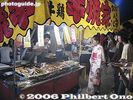
Food stall
|
|
|
|

Shishimai lion dance
|
|

Lantern-lit path to Taga Taisha
|
|

Sensoji temple's Kaminarimon Gate. There's a large road in front and also a large paved area where festivals are held. 雷門
|
|

Symbol of Tokyo: Kaminari-mon Gate with a giant red paper lantern. Pass through this gate to reach Asakusa Kannon Temple. 雷門
|
|

One of Tokyo's most photographed buildings: Kaminari-mon Gate with a giant red paper lantern.
|
|

Giant red paper lantern with the kanji characters "Kaminari Mon." The gate was reconstructed in 1960. The previous one was lost in a fire in 1865.
|
|

Under the lantern on the gold cap, there's "Matsushita Denki" (Matsushita Electric Industrial Co. or Panasonic). The current Kaminarimon Gate and giant lantern were rebuilt in 1960 as a donation by Konosuke Matsushita.
|
|

The lantern is covered with a protective net. The lantern can be collapsed like an accordion to allow tall objects (such as a mikoshi portable shrine during the Sanja Matsuri festival) to pass under the gate. It is also collapsed during typhoons.
|
|
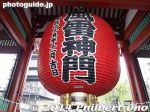
The famous Kaminarimon lantern was replaced with a new one in Nov. 2013. This is the back.
|
|
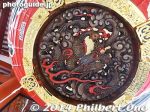
The bottom of the new Kaminarimon lantern has this nice artwork.
|
|

The temple is also called Kinryuzan, meaning Golden Dragon. 金龍山
|
|
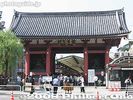
An unusual time when the giant lantern was removed for repairs. Asakusa looks very strange, almost naked, without the giant lantern.
|
|

Hozomon Gate
|
|

Hozomon Gate's giant paper lantern.
|
|
|

Hondo worship hall 本堂
|
|

Steps going up to the Hondo main worship hall.
|
|
|
|

Going to worship.
|
|
|
|
|
|

View from Hondo worship hall
|
|
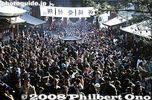
Crowd during New Year's
|
|
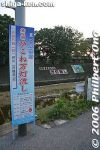
The Hikone Floating Lantern Festival (Manto Nagashi) is held on August 6 along Serigawa River. I saw it in 2006.
|
|
|
|
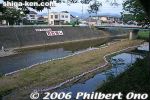
Lanterns along the river bank.
|
|

The lanterns will float down Serigawa River.
|
|
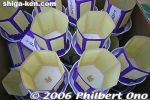
Lanterns have candles.
|
|
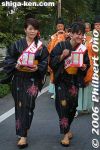
A procession arrived at the river led by the Hikone Castle Ambassadors.
|
|

Shrine priests.
|
|
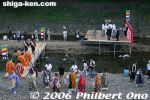
It looked like a multi-religion procession of local Shinto and Buddhist priests.
|
|
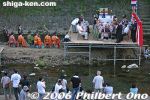
There was a small platform for an altar.
|
|
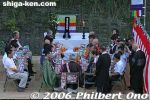
Priests chant in front of an altar.
|
|
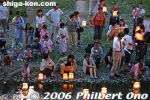
People start floating the lanterns.
|
|
|
|
|
|
|
|
|
|
|
|
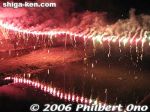
The festival climaxed with fireworks.
|
|
|
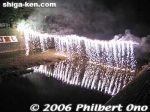
Niagara Falls fireworks.
|
|
|

On one end was this stage and lantern bearers representing all the mikoshi groups.
|
|

The dance parade was held along the Santsu Nakamurabashi shopping street that intersects with Nakamurabashi Station. Nakamurabashi is a short train ride from Ikebukuro Station on the Seibu Ikebukuro Line.
|
|
|
|
|
|
|
|
|